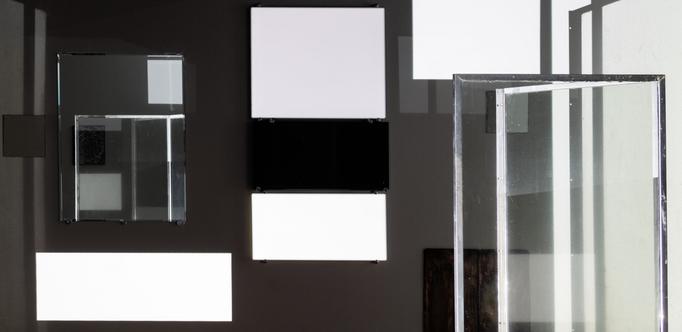Jan Tichy “Installation no 38 (Keck and Keck),” 2022, single-channel video projection on historical architecture and design elements from the House of Tomorrow inkjet print and silver gelatin photogram, ten minutes, no sound
The unusual optical phenomenon starts as soon as the sun rises in Elmhurst: sunlight shines throughout the McCormick House so bright that the reflections reach the main galleries of the Elmhurst Art Museum—past the restored carport, the entryway, and the hallway that was meant to separate the architecturally significant house from the museum building, thus revealing its original façade.
Breathing new life into the single-family home designed by Mies van der Rohe in 1952, is Jan Tichy, who’s been creating conceptual work at the intersection of video, sculpture, architecture, sound and photography for years. His installations exist between light and darkness, brightness and shadow, the visible and the invisible. “Reflectance” does just that.
Jan Tichy, “Reflectance (McCormick),” 2022, installation view
Illuminating the glass house, the museum and the surrounding space, Tichy responds to reflections and transparency by turning domestic objects—think historic dishwasher racks, bathroom mirrors, and doorknobs—into a kinetic mechanism. A nod to László Moholy-Nagy’s experimentation at the Bauhaus, the solar-powered installation features gleaming glass and metal surfaces. Part technology experiment, part sculptural design object, the installation sits in the middle of the McCormick House, where the living room used to be. As light goes through, motors rotate the reflective objects—all borrowed from George Fred Keck’s House of Tomorrow, the first glass house in America designed for the 1933 World’s Fair in Chicago—providing a real-time, solar architectural environment.

Jan Tichy, “Reflectance (McCormick),” 2022, installation view
More than illuminating the glass structure in elaborate ways, Tichy, fascinated by the McCormick House’s first inhabitants (real estate developer, Robert Hall McCormick III, his wife, poet Isabella Gardner, and her two children) researched their life and experiences in the house—their legacy includes works of poetry, photography, film and dance. To add to that—and to build in a way a legacy of his own—Tichy created a photographic series to reflect other material imprints of their lives. Namely, Gardner’s poetry books, “Birthdays from the Ocean” and “The Looking Glass,” which she wrote while living in the house. Exposing the pages to light from various angles, Tichy creates photograms that reveal a unique and distinctly personal approach.
Jan Tichy, “Reflectance (McCormick),” 2022, installation view
Beyond taking over the McCormick House, Tichy’s “Installation no. 38 (Keck & Keck)” is on display inside the museum as part of the “Houses of Tomorrow: Solar Homes from Keck to Today” exhibition. Blurring the lines between architecture, engineering and art, the work consists of a single-channel video projection aimed to bring together the past (building materials nearly a century old), the present (response by a contemporary artist), and the future (impact on the audience). Entering the gallery through thick, floor-length black curtains, the viewer is immersed into darkness. Tichy’s animated projection alters the space with reflections from historical fragments, reimagining the time and space of the House of Tomorrow.
Jan Tichy “Installation no 38 (Keck and Keck),” 2022, single-channel video projection on historical architecture and design elements from the House of Tomorrow inkjet print and silver gelatin photogram, ten minutes, no sound
By manipulating natural and artificial light, the minimalist artist creates a disembodied sculptural presence within the space—whether that’s the McCormick House or a single museum gallery. As he experiments with materials that refract and reflect light in particular ways, he turns viewers into participants: as they move within the space their bodies intersect and modify the fleeting forms as the light passes over and around them. And it is between light and shadow that his site-specific, architectural interventions provide an altered experience of space and the Self.
Elmhurst Art Museum, 150 Cottage Hill Avenue, Elmhurst, elmhurstartmuseum.org, (630)834-0202. Through May 29
Vasia RigouGreek-born Vasia Rigou is a seasoned journalist, editor and multimedia content producer largely on the subjects of visual art, culture, architecture and design. She currently serves as an Editor at Newcity, Chicago’s leading culture publication, as Writer and Copy Editor at the International Interior Design Association (IIDA) HQ, and regularly contributes to international architecture and design magazines OnOffice and ICON. She has experience creating content for brands and building conference speeches and influential TEDx talks. Simply put: she’s fascinated by finding out the great stories behind the people, places and objects that surround us, and by sharing those stories with the world. When she’s not writing about art or looking at art—wine in hand—she makes lists for pretty much everything, drinks immense amounts of coffee and takes cross-country road trips every chance she gets.Contact: hello@rigouvasia.com Website: www.rigouvasia.com
